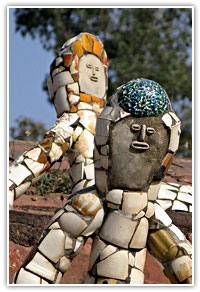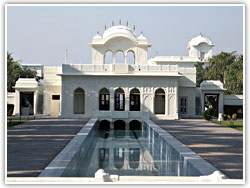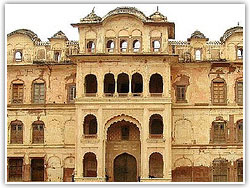|
|
Chandigarh Attractions
.............................................................................................................................................................................. |
|
Tourist
Attractions in Chandigarh
The main tourist attraction in Chandigarh is the Rock
garden. Besides the rock garden, the Rose Garden and Sukhna Lake are the other tourist attractions in
Chandigarh. |
| |
|
|
|
Rock Garden
The Rock Garden is a famous tourist attraction in
Chandigarh. This huge and special garden was built
by Nek Chand, who built this garden from broken
pieces of cups and saucers, bangles and other
waste materials. This garden is very unique in the
world and visited by tourists from all over the
world. The designer Shri Nek Chand still lives in
Chandigarh.
Rose Garden
The Rose Garden is the largest garden in Asia. It
is spread over 30 acres of beautifully landscaped
gardens and contains about 1,600 varieties of
roses.
Sukhna Lake
The two mountain torrents were canalized to form a
beautiful large lake called Sukhna Lake with a
wide boulevard. The Sukhna lake has become a
halting
|
 |
|
|
place
for birds migrating from Central Asia to India and vice
versa. It also offers various sports like boating,
yatching, water skiing, etc.
Excursions
from Chandigarh |
|
|
|
Pinjore
Pinjore is located about 20 km from Chandigarh on
Kalka road. Pinjore is known for the famous
Yadavindra Gardens. These gardens are very cool,
delightful and a popular picnic spot. This Mughal
gardens was laid out by Aurangzeb’s foster brother
Nawab Fidai Khan, who also designed the Badshahi
mosque in Lahore. Within the gardens, there are
various palaces built in a Mughal and Rajasthani
style like the Shish Mahal, Rang Mahal and Jai
Mahal. |
 |
|
|
|
|
Ludhiana
Ludhiana is situated about 20 km from Chandigarh. This
town is situated on the southern banks of the Sutlej
river and a major textile and light engineering centre.
Hero bicycles are also manufactured here. The rich
agricultural area around it supports a large grain
market. This city was founded in 1480 by Lodi prince
from Delhi and subsequently passed through a number of
hands and around it at Aliwal, Ferozeshah, Mudki and
Sobraon are important battlegrounds from the First Sikh
War. In the north-west of the town is the fort which
includes the shrine of Piri–I–Dastgir who was also known
as Abdul Kadir Galani. There is an annual pilgrimage of
Muslims and Hindus to the Muslim Saint’s tomb. There are
various other tombs that belongs to members of Shah
Shuja’s family while they were in exile from
Afghanistan. The town is also the home of the Christian
Medical College Hospital, which along with the CMC
hospital in Vellore, is one of the south Asia’s major
teaching and research hospitals.
Jalandhar
Jalandhar, formerly known as Jullundur is an ancient
city of which very little survives. This city was sacked
by Mahmud of Ghazni and under the Mughals it was an
important centre administering the area between the Beas
and Sutlej rivers. The cantonment area was established
in 1846 to house army units. It covers an area of 20
square km. The modern city of Jalandhar consists of a
number of wards, each originally enclosed by a wall. |
|
|
|
Patiala
Patiala was once the capital of an independent
state whose ruling Jind and Nabha houses were
Sikh. It suffered at the hands of the European
adventurer George Thomas and was later
consolidated into the Sikh Empire of Ranjit Singh
who included it in treaty arrangements made with
the British in 1809. Thereafter, the Maharaja
remained loyal to the British. Patiala is
surrounded by intensively cultivated fields and
has no palaces or pleasure gardens. The most
|
 |
|
|
impressive building in this town is the Bahadurgarh
Fort, which was the creation of Maharaja Ala Singh in
the late 18th century. It is a huge concentric fort with
two walls surrounded by a moat. This large fort is built
on a plain and capable of housing a garrison large
enough to repulse strong attacks like the fierce Maratha
attempt in 1794. The Old Motibagh Palace of 19th century
is one of the largest homes in Asia. This huge and
rambling central building is surrounded by lawns and
tress. A combination of European, Rajput and Mughal
styles, part of it is now National Institute for Sports.
There are 15 dining halls and various outbuildings.
Kapurthala
Kapurthala is situated about 19 kms. from Jalandhar.
Kapurthala was the capital of the former Sikh princely
state. It was also the home town of the Ahluwalia family
who conquered it in 1747. Its army fought against the
British at Aliwal in the first Sikh War but took the
British side during the Second Sikh War (1848) and the
Mutiny (1857). This city was later governed as a model
city–state. The Jagajit Singh who ascended the throne in
1890 and was educated in France, attempted to turn the
city into a scrap of Paris. The Jalaukhana, designed by
Monsieur Marcel and based in part on Fontainebleau, was
first built in red sandstone but later built in pink
stucco, was the Maharaja’s palace. It is now a boys
school.
Anandpur Sahib
Anandpur Sahib is a picturesque village, situated about
75 km towards Dharamsala from Chandigarh. This village
is framed between the Shivalik hills to the east and the
Sutlej river in the west. This historical site also
boasts of an imposing 17th century fortress and an
impressive Gurudwara. It is one of the holiest Sikh
shrines. |
|